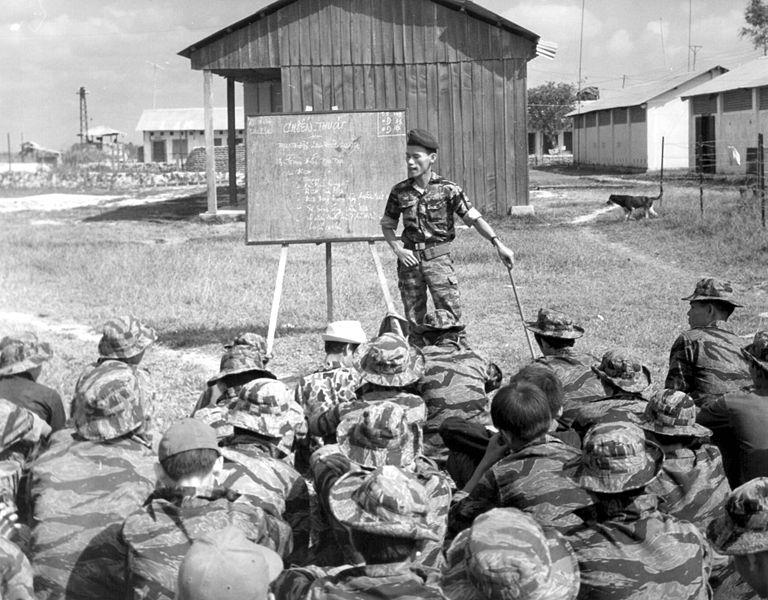From 1954 to 1959, the period of Vietnam War was characterized by the separation of Vietnam with two nations. Occurring after the First Indochina War with the exit of the French, Geneva Conference partitioned Vietnam into North and South. Yet, this caused the fighting between communists’ government in the north and the government of Republic of Vietnam in the south with the support of the U.S. During this period, Northern Vietnam was conducting recovery from the wounds of anti-French resistance war. The reputation of Ho Chi Minh increasingly grew. The U.S President worried about the development of communism in Vietnam. Thus, the U.S backed Ngo Dinh Diem to form an anti-communist government in the south with Ngo Dinh Diem as president. In a speech to American Friends of Vietnam, John F. Kennedy, then a U.S Senator, said that if the Red Tide of Communism flourished in Vietnam, the security of other neighbor countries of Vietnam such as Laos and Cambodia would be threatened. As according to the Domino Theory which was proposed as policy by the Eisenhower administration, if communist forces appealed one country successfully, it will result in the following of other countries.

In early summer of 1955, a campaign on denouncing communists was launched by Ngo Dinh Diem. During this campaign, communists and other opponents of the government in South Vietnam were arrested, interned, persecuted, or executed. Ngo Dinh Diem instituted the death sentence against any communist activity in August 1956. According to Gabriel Kolko, it was estimated that there were about 12,000 doubted objectors of Diem executed between 1955 and 1957; by late 1958, about 40, 000 political prisoners had been jailed. Yet, according to Guenter Lewy, the figure was exaggerated, in fact, there were about more than 35, 000 prisoners of all kinds in the entire country. As a fervent Catholic, Ngo Dinh Diem was regarded by many ordinary Vietnamese as part of the old elite supporting the French rule Vietnam. Vietnamese people majorly were Buddhist. Therefore, his attack on the Buddhist community only served to deepen mistrust. Human rights abuses, under Diem regime, increasingly estranged the population. As hostility to the rule of Diem regime in South Vietnam developed, a small-scale insurgency began to come into being in 1957. Four hundred officials of government were assassinated in that year. In May 1957, Ngo Dinh Diem paid a ten-day visit to the United States. To welcome the arrival of Ngo Dinh Diem, a parade was held in New York City. In this visit, the U.S President, Eisenhower pledged to continued American support for Vietnam. In spite of being praised publicly, Ngo Dinh Diem had been selected before in private Secretary of State, as there were no better alternatives.
During 1954 – 1957, Diem government managed to suppress a high-level disagreement in the countryside. At the beginning of 1957, Southern Vietnam gained its first peace in over ten years. However, from 1957 to 1959, because the government did not deduced increasingly incidents of violence, the disorders were seen too widespread to warrant committing Government of Vietnam resources. By 1959, the disorders are seen as an organized campaign, thus, Ngo Dinh Diem conducted Law 10/59 in which political rebellion were punished by death and property confiscation. Besides, among former Viet Minh some divisions happened. The main goal was to hold an election cross the country as discussed in the Geneva Conference triggered “wildcat” activities. These activities were separate from other communists and anti-Government of Vietnam activists.

In December 1960, all anti-Government of Vietnam activists (including non-communists) founded the National Liberation Front (Viet Cong). In Pentagon Papers, Viet Cong played an important role in forcing the withdrawal of American advisors and influence, in land reform and liberalization of the Government of Vietnam. The purpose of the National Liberation Front was to connect people of all levels in the countryside. The Viet Minh had conducted land reform and restored a large number of land to poor peasants. Meanwhile, landowners came back to the village according to the plan of Ngo Dinh Diem. Farmers in the villages had to return land to landlords and pay rents for the previous year. Insurgency activity against Saigon government started in the south under southern leadership in 1958. To counter the accusation that North Vietnam was violating the Geneva Conference, the independence of the Viet Cong was stressed in communist propaganda. In March 1956, Le Duan, the southern communist leader showed a plan to re-establish the insurgency called “The Road to the South” to the other member of the Politburo in Hanoi. Although the plan was rejected by China and the Soviet Union, the North Vietnamese leadership approved tentative measures to revive the southern insurgency in December 1956. After two year, 1958, communist forces were set up as a single command structure.
